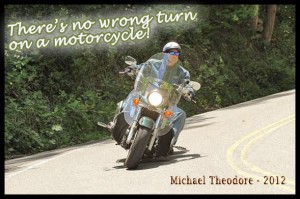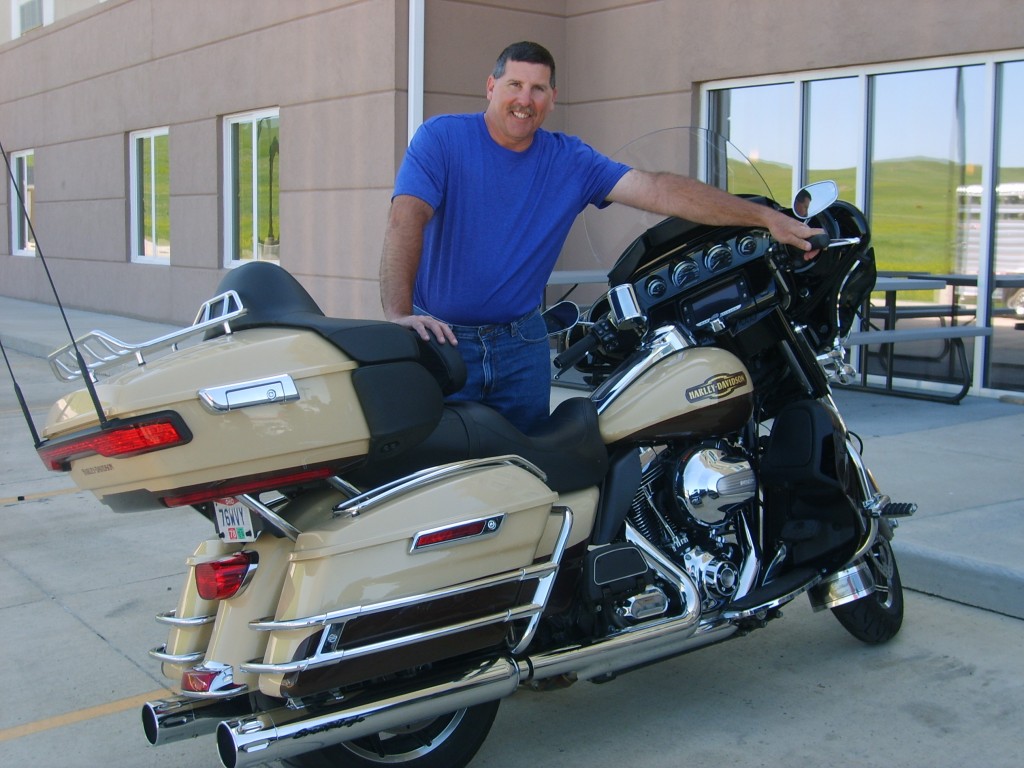Lines through a corner
Compared to roads in a flat country, roads in mountain areas have far more corners, and those corners are often really tight.
Start in the outside
Very important in the mountains is the line you ride through a corner. Always start at the outside: in a corner to the left you start at the right side, and in a corner to the right you start left.
If the road is narrow, you can even use the part of the road for oncoming traffic. The advantage is that you will see oncoming traffic earlier than when you stay inside the corner.
Look through the corner
Hold on to the outside line for a long time. There will be a moment when you can look through the rest of the corner in one straight line. That’s the point where you turn in for the second time, and then ride along that straight line. That will be the only time that you touch the inside line through the corner.
Try not to reach the lane for oncoming traffic, in a left turn. In that case there will be space if you need more space, and at the same time you train yourself riding tight corners.
And in a blind corner, you should not only expect cars or trucks, but also all types of animals one would expect in the mountains.
On really narrow roads with hairpins, don’t begin on the lane for oncoming traffic: in that case, there might be not enough time to get back to the right side of the road when a local arrives from the other side.
Try to keep your head inside your own lane as well, in corners to the left or to the right.
Looking ahead
Looking ahead
Before entering a hairpin or switchback, always look up or down, so you know in advance what you will encounter during the turn.
Often, you can see through more than one corner (even when the corner before you itself is blind). The more you try to see what is in front of you on the road, the more you know about the oncoming traffic, and where you can expect them.
Throttle
On the throttle
Always try to keep the throttle open (a bit) during a corner. The corner will certainly be easier that way.
When going up, keep the speed above the minimum that is needed not to stall, because you don’t want to stall in the middle of a hairpin, and squeezing the clutch while going up won’t help either.
If you descend, keeping the throttle open often is difficult, but do try, as it will make life easier.
Stalling
When your motorcycle is going to stall mid-turn, let it stall. *Don’t* pull the clutch: the motorcycle will go backward, down, and you would be pulled along.
To brake
Upward: rear brake
When you ride upwards, you can use the rear brake during turns: that will stabilize the bike, and it allows you to keep the throttle open during the turn.
Downward: front brake
But downward, the rear brake is of no use: the rear wheel almost carries no weight, which means it will stop turning very easily when you apply the rear brake.
If you ride steep downward and you have to brake, use the front brake.
Why no rear brake downward?
If you ride downward, almost all the weight of the bike is on the front wheel. Therefore, it is very easy to lock the rear wheel when you use the rear brake.
In that case, the rear wheel will try to get past the front wheel, which will take you and the bike down.
Try to use the compression of the engine to brake, and when you need more brakes, use the front.
Do not brake while in the turn
If you must brake do your braking before the corner not going into it this will stand your bike upright into the wrong direction you need to be going.
Downward
Preferably with the throttle open!
Riding up is not a problem, most of the time; it is riding downward that is the most difficult.
Try to use the engine brake: shift downward until you have the right speed without the throttle, or with a bit of throttle.
In a turn, open the throttle a bit.
When it is so steep that your speed is too high, even in the first gear, you will have to use the brake as well (the front, that is).
Fear of heights
Look in front of you
Do you have fear of heights, and do you get dizzy when looking down? Then don’t!
Concentrate on the road ahead, and look forward: far, far forward
Stopping and getting away
Upward
If you have to come to a standstill while riding upward, you can keep your foot on the rear brake. Just keep the bike in the first gear, and it’s easy to ride away again.
When the surface of the road is a bit loose, let the clutch go slowly to ride away, You can drag both your feet on the ground for added safety. Once you feel comfortable at that moment, you can open up the throttle a bit, and you let go of the rear brake.
Downward
Downward, you come to a standstill with the front brake. Pulling away is even possible without the engine. Hold your clutch in some while releasing your brake as you are now starting to roll.
Parking
Mind the other traffic
Remember, when you park to enjoy the views, or to take a picture, that you park your motorcycle in a spot where it can be easily seen from both sides.
Sometimes you think to see a spot that is perfectly fit to park, and it happens to be a spot to let cars pass each other on narrow roads. Those spots are there for passing, so don’t use them!
Sloping surface
While parking, you will notice the results of the three dimensions in the mountains: where you would otherwise feel the surface with your foot, there may be nothing… the surface is sometimes further away than you are used to. So look where you stop, and check which foot to use to carry your weight.
Foot on the back brake
If you stop while riding upwards, you should make sure that your right foot can stay on the peg, because you need the back brake in that situation.
Try to park you bike with its front pointing upwards: otherwise, it might ride off the side stand. Also: keep it in first gear.
The side stand
If you have to park with the front of the bike pointing downwards, the bike could fall, even when parked in gear,
because sometimes gravity pulls harder.
And always try to check the situation with respect to riding away again. In principle, it is no big deal when you first have to let the bike go a bit downward, but if you would have to turn it at the same time, getting away could become a bit of a problem.
The weather
Change of weather
You may experience huge changes of temperature when riding upwards or downwards in the mountains. So always carry something warm, and especially something which keeps out the rain as in rain gear.
What is also likely to happen, is that you ride in very bright sun light, and suddenly, after a corner, you enter a thick fog. or dark shadows of the tress.
The weather high in the mountains can change very suddenly, from summer to winter, from thunderstorm to clear skies, from snow to fog to bright clear sun.
So carry a riding jacket and rain gear sunglasses.
Slippery
Above 2000 ft means a chance of slippery roads, or even black ice. When it is raining up on the mountains.
Being polite
Allowing people to pass
When you are experiencing your first mountain ride, your speed will probably be much lower than the speed of people who are used to riding the mountains. Especially people living there will know each corner, and are able to ride certain passes blindfolded.
Don’t be tempted to try to keep in front of them. Try to maintain your own comfort speed, and let people who are faster than you in corners, pass. Move to the right to let them pass you.
So don’t open up the throttle after each corner to make up for a slow corner: on the contrary, use straight stretches to slow down, so people can easily get past you. Ride your own ride.
When you are getting used to mountain riding, and your own speed gets higher, you will notice that some people will let you pass in the same way, and you will be grateful.
So, check your mirrors often!
Oncoming traffic
The same politeness also applies to oncoming traffic. So just try to determine for whom it is most easy to stop (which will often be you, the motorcycle rider).
When you see a Truck, don’t enter a hairpin with the idea that the truck will have to wait because you have as much right on that hairpin as the truck, but find a place to pull aside far right as you can get instead. Because that truck will now take up your lane also on the curves.
Most people who ride and drive in the mountains are very courteous, as you will notice, and it is a pleasant feeling to be one of them.
Badly running engine
Less oxygen
If your motorcycle doesn’t have injection, you may experience a badly running engine at heights. The air becomes thinner, and your bike will receive less oxygen, while the amount of fuel stays the same: so the mix will become too rich.
Some motorcycles will protest. The fuel consumption rises (with a well running engine, fuel consumption will decrease in the mountains), and the engine seems to want to give up.
Air filter
In such a case, don’t fumble with the needles, but, as a temporary measurement, take off the air filter. The amount of air in the mixture will increase, which will compensate a bit for the decreased percentage of oxygen.
Distances
Less miles in a day
When planning your trip, keep in mind that you will cover much smaller distances in the mountains, especially when you go up and down through hairpins. A distance of 50 miles doesn’t mean that you will be there in half an hour!
It applies even more for the distance on the map: on the road, you will cover vertical miles as well.
Also be aware of the fact that gas stations on top of mountain passes are rare. Always make sure you start off your ride with a full take and to top off any chance you get.





